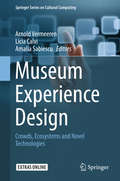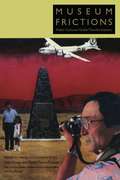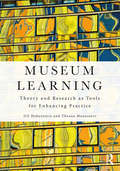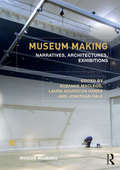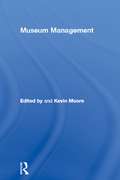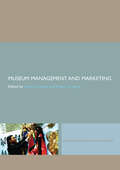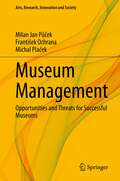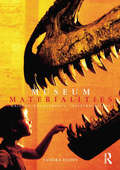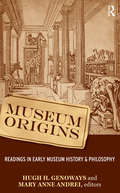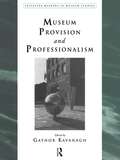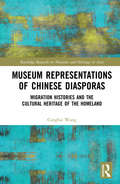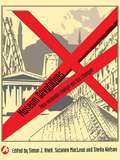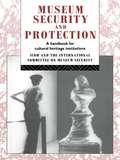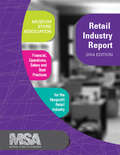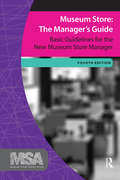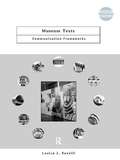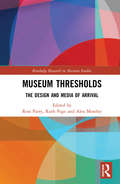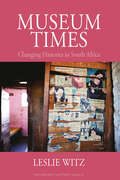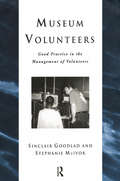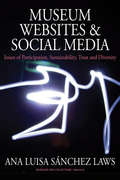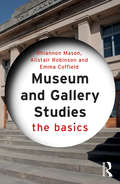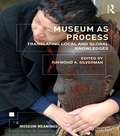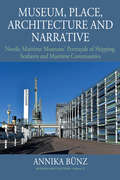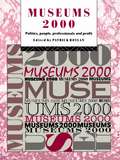- Table View
- List View
Museum Experience Design
by Arnold Vermeeren Licia Calvi Amalia SabiescuThis state-of-the-art book explores the implications of contemporary trends that are shaping the future of museum experiences. In four separate sections, it looks into how museums are developing dialogical relationships with their audiences, reaching out beyond their local communities to involve more diverse and broader audiences. It examines current practices in involving crowds, not as passive audiences but as active users, co-designers and co-creators; it looks critically and reflectively at the design implications raised by the application of novel technologies, and by museums becoming parts of connected museum systems and large institutional ecosystems. Overall, the book chapters deal with aspects such as sociality, creation and sharing as ways of enhancing dialogical engagement with museum collections. They address designing experiences – including participatory exhibits, crowd sourcing and crowd mining – that are meaningful and rewarding for all categories of audiences involved. Museum Experience Design reflects on different approaches to designing with novel technologies and discusses illustrative and diverse roles of technology, both in the design process as well as in the experiences designed through those processes. The trend of museums becoming embedded in ecosystems of organisations and people is dealt with in chapters that theoretically reflect on what it means to design for ecosystems, illustrated by design cases that exemplify practical and methodological issues in doing so. Written by an interdisciplinary group of design researchers, this book is an invaluable source of inspiration for researchers, students and professionals working in this dynamic field of designing experiences for and around museums.
Museum Frictions: Public Cultures/Global Transformations
by Ivan Karp Corinne A. Kratz Lynn Szwaja Tomás Ybarra-FraustoMuseum Frictions is the third volume in a bestselling series on culture, society, and museums. The first two volumes in the series, Exhibiting Cultures and Museums and Communities, have become defining books for those interested in the politics of museum display and heritage sites. Another classic in the making, Museum Frictions is a lavishly illustrated examination of the significant and varied effects of the increasingly globalized world on contemporary museum, heritage, and exhibition practice. The contributors--scholars, artists, and curators--present case studies drawn from Africa, Australia, North and South America, Europe, and Asia. Together they offer a multifaceted analysis of the complex roles that national and community museums, museums of art and history, monuments, heritage sites, and theme parks play in creating public cultures. Whether contrasting the transformation of Africa's oldest museum, the South Africa Museum, with one of its newest, the Lwandle Migrant Labor Museum; offering an interpretation of the audio guide at the Guggenheim Bilbao; reflecting on the relative paucity of art museums in Peru and Cambodia; considering representations of slavery in the United States and Ghana; or meditating on the ramifications of an exhibition of Australian aboriginal art at the Asia Society in New York City, the contributors highlight the frictions, contradictions, and collaborations emerging in museums and heritage sites around the world. The volume opens with an extensive introductory essay by Ivan Karp and Corinne A. Kratz, leading scholars in museum and heritage studies. Contributors. Tony Bennett, David Bunn, Gustavo Buntinx, Cuauhtmoc Camarena, Andrea Fraser, Martin Hall, Ivan Karp, Barbara Kirshenblatt-Gimblett, Corinne A. Kratz, Christine Mullen Kreamer, Joseph Masco, Teresa Morales, Howard Morphy, Ingrid Muan, Fred Myers, Ciraj Rassool, Vicente Razo, Fath Davis Ruffins, Lynn Szwaja, Krista A. Thompson, Leslie Witz, Toms Ybarra-Frausto
Museum Informatics: People, Information, and Technology in Museums (Routledge Studies in Library and Information Science #Vol. 2)
by Paul F. Marty Katherine Burton JonesMuseum Informatics explores the sociotechnical issues that arise when people, information, and technology interact in museums. It is designed specifically to address the many challenges faced by museums, museum professionals, and museum visitors in the information society. It examines not only applications of new technologies in museums, but how advances in information science and technology have changed the very nature of museums, both what it is to work in one, and what it is to visit one. To explore these issues, Museum Informatics offers a selection of contributed chapters, written by leading museum researchers and practitioners, each covering significant themes or concepts fundamental to the study of museum informatics and providing practical examples and detailed case studies useful for museum researchers and professionals. In this way, Museum Informatics offers a fresh perspective on the sociotechnical interactions that occur between people, information, and technology in museums, presented in a format accessible to multiple audiences, including researchers, students, museum professionals, and museum visitors.
Museum Learning: Theory and Research as Tools for Enhancing Practice
by Jill Hohenstein Theano MoussouriAs museums are increasingly asked to demonstrate not only their cultural, but also their educational and social significance, the means to understand how museum visitors learn becomes ever more important. And yet, learning can be conceptualised and investigated in many ways. Coming to terms with how theories about learning interact with one another and how they relate to ‘evidence-based learning’ can be confusing at best. Museum Learning attempts to make sense of multiple learning theories whilst focusing on a set of core learning topics in museums. Importantly, learning is considered not just as a cognitive characteristic, as some perspectives propose, but also as affective, taking into consideration interests, attitudes, and emotions; and as a social practice situated in cultural contexts. This book draws attention to the development of theory and its practical applications in museum situations such as aquariums, zoos, botanical gardens and historical re-enactment sites, among others. This volume will be of interest to museum studies students, practitioners and researchers working in informal learning contexts, and will help them to reflect on what it means to learn in museums and create more effective environments for learning.
Museum Making: Narratives, Architectures, Exhibitions (Museum Meanings)
by Suzanne MacLeod Jonathan Hale Laura Hourston HanksOver recent decades, many museums, galleries and historic sites around the world have enjoyed an unprecedented level of large-scale investment in their capital infrastructure, in building refurbishments and new gallery displays. This period has also seen the creation of countless new purpose-built museums and galleries, suggesting a fundamental re-evaluation of the processes of designing and shaping of museums. Museum Making: Narratives, Architectures, Exhibitions examines this re-making by exploring the inherently spatial character of narrative in the museum and its potential to connect on the deepest levels with human perception and imagination. Through this uniting theme, the chapters explore the power of narratives as structured experiences unfolding in space and time as well as the use of theatre, film and other technologies of storytelling by contemporary museum makers to generate meaningful and, it is argued here, highly effective and affective museum spaces. Contributions by an internationally diverse group of museum and heritage professionals, exhibition designers, architects and artists with academics from a range of disciplines including museum studies, theatre studies, architecture, design and history cut across traditional boundaries including the historical and the contemporary and together explore the various roles and functions of narrative as a mechanism for the creation of engaging and meaningful interpretive environments.
Museum Management (Leicester Readers in Museum Studies)
by Kevin MooreCollecting a selection of essential writings by some of the leading authors in the field, Kevin Moore examines the developments in, and effectiveness of, museum management in a world dominated by new and exciting heritage and leisure attractions. The selected papers in Museum Management outline the development of museum management to date, the challenges museums currently face, and the key areas of future development in management and marketing practice, and addresses: strategic management issues: policy formulation, corporate planning and performance measurement human resource management financial management the importance of marketing. This volume is an invaluable introduction to the key issues, controversies and debates in the subject. It will be essential reading for all students, museum managers and staff who need to keep up to date with latest developments in this field.
Museum Management and Marketing (Leicester Readers in Museum Studies)
by Richard Sandell Robert R. JanesDrawing together a selection of high quality, intellectually robust and stimulating articles on both theoretical and practice-based developments in the field, this Reader investigates the closely linked areas of management and marketing in the museum. The articles, from established and world-renowned contributors, practitioners and writers at the leading edge of their fields, deal with the museum context of management and how marketing and management practices must take account of the specifics of the museum and the not-for-profit ethos. Key writings from broader literature are included, and the collection of key writings on the investigation and study of management and marketing in the museum are of great benefit not only to those studying the subject, but also to professionals working and developing within the field.
Museum Management: Opportunities and Threats for Successful Museums (Arts, Research, Innovation and Society)
by Michal Plaček František Ochrana Milan Jan PůčekThis book centers on museum management with particular focus on risk management. It sees the museum as a modern institution that, in addition to its classical heritage function (collections management), also provides an educational function and implements this education through experience (the experiential function of the museum). It represents a combination of academic excellence and experience from real managers from museums and other public institutions. Additional topics such as strategic and operational museum management and museum research management are discussed and case studies from daily management practice are included.
Museum Materialities: Objects, Engagements, Interpretations
by Sandra H. DudleyThis is an innovative interdisciplinary book about objects and people within museums and galleries. It addresses fundamental issues of human sensory, emotional and aesthetic experience of objects. The chapters explore ways and contexts in which things and people mutually interact, and raise questions about how objects carry meaning and feeling, the distinctions between objects and persons, particular qualities of the museum as context for person-object engagements, and the active and embodied role of the museum visitor. Museum Materialities is divided into three sections – Objects, Engagements and Interpretations – and includes a foreword by Susan Pearce and an afterword by Howard Morphy. It examines materiality and other perceptual and ontological qualities of objects themselves; embodied sensory and cognitive engagements – both personal and across a wider audience spread – with particular objects or object types in a museum or gallery setting; notions of aesthetics, affect and wellbeing in museum contexts; and creative and innovative artistic and museum practices that seek to illuminate or critique museum objects and interpretations. Phenomenological and other approaches to embodied experience in an emphatically material world are current in a number of academic areas, most particularly strands of material culture studies within anthropology and cognate disciplines. Thus far, however, there has been no concerted application of this kind of approach to museum collections and interactions with them by museum visitors, curators, artists and researchers. Bringing together essays by scholars and practitioners from a wide disciplinary and international base, Museum Materialities seeks to make just such a contribution. In so doing it makes a valuable and original addition to the literature of both material culture studies and museum studies.
Museum Origins: Readings in Early Museum History and Philosophy
by Hugh H. Genoways Mary Anne AndreiWith the development of institutions displaying natural science, history, and art in the late 19th century came the debates over the role of these museum in society. This anthology collects 50 of the most important writings on museum philosophy dating from this formative period, written by the many of the American and European founders of the field. Genoways and Andrei contextualize these pieces with a series of introductions showing how the museum field developed within the social environment of the era. For those interested in museum history and philosophy or cultural history, this is an essential resource.
Museum Provision and Professionalism (Leicester Readers in Museum Studies)
by Gaynor KavanaghMuseums are public places where objects, images and memories are kept and shared. They exist in infinite variety and contradiction. They can be places of great excitement and great boredom, sharply insightful and hopelessly bland. Museums are anything that the political climate and the imagination allows them to be. No two museums are the same. The papers which make up this volume give ample evidence of the variety of views that exist about museums. They also demonstrate that museums and museum professionals are moving forward with energy and conviction. This volume will be invaluable to students and museum professionals and will provoke them to consider museum provision and professionalism in all their forms.
Museum Representations of Chinese Diasporas: Migration Histories and the Cultural Heritage of the Homeland (Routledge Research on Museums and Heritage in Asia)
by Cangbai WangMuseum Representations of Chinese Diasporas is the first book to analyse the recent upsurge in museums on Chinese diasporas in China. Examining heritage-making beyond the nation state, the book provides a much-needed, critical examination of China’s engagement with its diasporic communities. Drawing on fieldwork in more than ten museums, as well as interviews with museum practitioners and archival study, Wang offers a timely analysis of the complex ways in which Chinese diasporas are represented in the museum space of China, the ancestral homeland. Arguing that diasporic heritage is highly ambivalent and introducing a diasporic perspective to the study of cultural heritage, this book opens up a new avenue of inquiry into the study and management of cultural heritage in China and beyond. Most importantly, perhaps, Wang sheds new light on the dynamic between China and Chinese diasporas through the lens of the museum. Museum Representations of Chinese Diasporas takes a transnational perspective that will draw attention to the under-researched connections between heritage, mobility and meaning in a global context. As such, this cross-disciplinary work will be of interest to scholars and students working in the museum and heritage studies fields, as well as those studying Asia, China, migration and diaspora, anthropology, history and culture.
Museum Revolutions: How museums change and are changed
by Sheila Watson Simon J. Knell Suzanne MacLeodThis single-volume museum studies reference title explores the ways in which museums are shaped and configured and how they themselves attempt to shape and change the world around them. Written by a leading group of museum professionals and academics from around the world and including new research, the chapters reveal the diverse and subtle means by which museums engage and in so doing change and are changed. The authors span over 200 years discussing national museums, ecomuseums, society museums, provincial galleries, colonial museums, the showman’s museum, and science centres. Topics covered include: disciplinary practices, ethnic representation, postcolonial politics, economic aspiration, social reform, indigenous models, conceptions of history, urban regeneration, sustainability, sacred objects, a sense of place, globalization, identities, social responsibility, controversy, repatriation, human remains, drama, learning and education. Capturing the richness of the museum studies discipline, Museum Revolutions is the ideal text for museum studies courses, providing a wide range of interlinked themes and the latest thought and research from experts in the field. It is invaluable for those students and museum professionals who want to understand the past, present and future of the museum.
Museum Security and Protection: A Handbook for Cultural Heritage Institutions (Heritage: Care-Preservation-Management)
by David ListonThe ICMS Handbook is acknowledged as the international standard text for basic security procedures. It was first published as A Basic Guide to Museum Security, and is now fully revised, enlarged and updated. The manual covers: general principles security, theft and burglary: security personnel; training; collection management and transport; disaster planning; fire and environmental hazards; checklist of security procedures. It is designed to operate in all conditions and sizes of museum, not merely those with elaborate electronic security. It stresses that good basic principles are the key to effective protection from hazard.
Museum Store Association Retail Industry Report, 2014 Edition: Financial, Operations, Salary, and Best Practices Information for the Nonprofit Retail Industry (Museum Store Association)
by Museum Store AssociationThe 2014 MSA Retail Industry Report provides benchmarks, gives insight, and enables you to make smart business decisions to maximize sales in your museum store. The report includes over 200 tables, including comparisons by geography, size, gross sales, and museum type with which to compare your own store. Tips concerning best practices in stocking, merchandising, and staffing, based on hard survey data, are provided. Information on web sales, catalogues, wholesaling, and special events are also included.
Museum Store: Basic Guidelines for the New Museum Store Manager (Museum Store Association)
by Museum Store AssociationMuseum Store: The Manager's Guide is a practical guide for any store manager who needs guidance about visual merchandising, measuring performance, managing volunteers and much more. This eight-chapter volume includes a wealth of advice on best practices compiled by the national professional organization of museum stores. It includes a myriad of supportive worksheets to help the novice manager. It provides guidance from experienced store managers to assist the novice in evaluating a store’s performance. The 4th edition includes updated information on social media and mobile shopping. A new chapter to this valuable resource highlights the legal implications of the business of nonprofit retail including copyright, unrelated business income tax, and staff relations. A great resource for every back office!
Museum Texts: Comunication Frameworks (Museum Meanings)
by Louise RavelliAnswering key questions in the study of how museums communicate, Louise Ravelli provides a set of frameworks to investigate the complexities of communication in museums: * What is an appropriate level of complexity for a written label?* Why do some choice in language make a more direct relation to visitors?* Is there a correct way of presenting a particular view of content?* How do design practices contribute to the overall meanings being made? The frameworks enhance the way we critically analyze and understand museums text, both in the sense of conventional – written texts in museums – and in an expanded sense of the museum as a whole operating as a communicative text. Using a wide range of examples Ravelli argues that communication contributes fundamentally to what a museum is, who it relates to and what it stands for. Not only museum studies and communications studies students, but also professionals in the field will find Museum Texts an indispensable guide on communication frameworks.
Museum Thresholds: The Design and Media of Arrival (Routledge Research in Museum Studies)
by Ruth Page Ross Parry Alex MoseleyMuseum Thresholds is a progressive, interdisciplinary volume and the first to explore the importance and potential of entrance spaces for visitor experience. Bringing together an international collection of writers from different disciplines, the chapters in this volume offer different theoretical perspectives on the nature of engagement, interaction and immersion in threshold spaces, and the factors which enable and inhibit those immersive possibilities. Organised into themed sections, the book explores museum thresholds from three different perspectives. Considering them first as a problem space, the contributors then go on to explore thresholds through different media and, finally, draw upon other subjects and professions, including performance, gaming, retail and discourse studies, in order to examine them from an entirely new perspective. Drawing upon examples that span Asia, North America and Europe, the authors set the entrance space in its historical, social and architectural contexts. Together, the essays show how the challenges posed by the threshold can be rethought and reimagined from a variety of perspectives, each of which have much to bring to future thinking and design. Combining both theory and practice, Museum Thresholds should be essential reading for academics, researchers and postgraduate students working in museum studies, digital heritage, architecture, design studies, retail studies and media studies. It will also be of great interest to museum practitioners working in a wide variety of institutions around the globe.
Museum Times: Changing Histories in South Africa (Museums and Collections #16)
by Leslie WitzMuseums flourished in post-apartheid South Africa. In older museums, there were renovations on the go, and at least fifty new museums opened. Most sought to depict violence and suffering under apartheid and the growth of resistance. These unlikely journeys are tracked as museums became a primary setting for contesting histories. From the renowned Robben Island Museum to the almost unknown Lwandle Migrant Labour Museum, the author demonstrates how an institution concerned with the conservation of the past is simultaneously a site for changing history.
Museum Volunteers: Good Practice in the Management of Volunteers (Heritage: Care-Preservation-Management)
by Sinclair Goodlad Stephanie McIvorMuseum Volunteers is a practical handbook on the use of volunteers as interpreters within museums. Drawing on key examples of outstanding practice from the UK and North America, this book forms a unique resource on volunteerism.This book:* reviews research on the changing priorities of museums* examines a form of volunteering that has provided benefits to all participants in an activity similar to museum interpretation - student tutoring* describes and analyses the strengths of five exceptional volunteer programmes in Canada and the USA* reports the finding of five volunteer programmes set up and managed by the authors in the Science Museum, London* examines the development process of the pilot studies and the consequent establishment of a permanent volunteer programme in the Science Museum, London* discusses the mutual benefits that volunteer programmes can bring to museums and volunteers* offers suggestions on the practical day-to-day management and administration of volunteers.This book is essential reading for anyone involved with the management and administration of a museum, or, is thinking of offering their services to a museum as a volunteer.
Museum Websites and Social Media: Issues of Participation, Sustainability, Trust and Diversity (Museums and Collections #8)
by Ana Sánchez LawsOnline activities present a unique challenge for museums as they harness the potential of digital technology for sustainable development, trust building, and representations of diversity. This volume offers a holistic picture of museum online activities that can serve as a starting point for cross-disciplinary discussion. It is a resource for museum staff, students, designers, and researchers working at the intersection of cultural institutions and digital technologies. The aim is to provide insight into the issues behind designing and implementing web pages and social media to serve the broadest range of museum stakeholders.
Museum and Gallery Studies: The Basics (The Basics)
by Rhiannon Mason Alistair Robinson Emma CoffieldMuseum and Gallery Studies: The Basics is an accessible guide for the student approaching Museum and Gallery Studies for the first time. Taking a global view, it covers the key ideas, approaches and contentious issues in the field. Balancing theory and practice, the book address important questions such as: What are museums and galleries? Who decides which kinds of objects are worthy of collection? How are museums and galleries funded? What ethical concerns do practitioners need to consider? How is the field of Museum and Gallery Studies developing? This user-friendly text is an essential read for anyone wishing to work within museums and galleries, or seeking to understand academic debates in the field.
Museum as Process: Translating Local and Global Knowledges (Museum Meanings)
by Raymond SilvermanThe museum has become a vital strategic space for negotiating ownership of and access to knowledges produced in local settings. Museum as Process presents community-engaged "culture work" of a group of scholars whose collaborative projects consider the social spaces between the museum and community and offer new ways of addressing the challenges of bridging the local and the global. Museum as Process explores a variety of strategies for engaging source communities in the process of translation and the collaborative mediation of cultural knowledges. Scholars from around the world reflect upon their work with specific communities in different parts of the world – Australia, Canada, Ghana, Great Britain, New Zealand, Papua New Guinea, Philippines, South Africa, Taiwan and the United States. Each global case study provides significant insights into what happens to knowledge as it moves back and forth between source communities and global sites, especially the museum. Museum as Process is an important contribution to understanding the relationships between museums and source communities and the flow of cultural knowledge.
Museum, Place, Architecture and Narrative: Nordic Maritime Museums’ Portrayals of Shipping, Seafarers and Maritime Communities (Museums and Collections #15)
by Annika BünzA characteristic trait of the maritime museums is that they are often located in a contemporary and/or historical environment from which the collections and narratives originate. The museum can thereby be directly linked to the site and its history. It is therefore vital to investigate the maritime museums in terms of relationships between landscape, architecture, museum and collections. This volume unravels the kinds of worlds and realities the Nordic maritime museums stage, which identities and national myths they depict, and how they make use of both the surrounding maritime environments and the architectural properties of the museum buildings.
Museums 2000: Politics, People, Professionals and Profit (Heritage: Care-Preservation-Management)
by Patrick J. BoylanMuseum and art galleries have never been so much in the news as they have been over the past decade. Yet public focus at both professional and non-specialist levels has been remarkable for what has been accidentally or deliberatley left out of recent debates. Moving beyond the narrow issues of professional practice, Museums 2000 probes the political, economic and cultural realities which affect museums today. Because the contributos are drawn from the museum profession and the wider political, academic and business community worldwide, the book is truly international, reflecting the issues which affect all museums.
